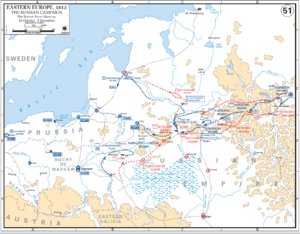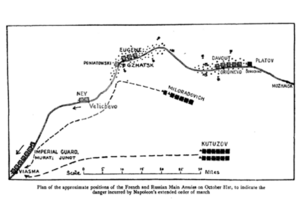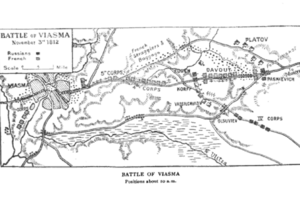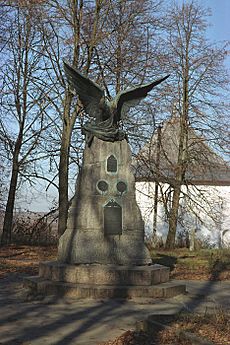Battle of Vyazma facts for kids
Quick facts for kids Battle of Vyazma |
|||||||
|---|---|---|---|---|---|---|---|
| Part of the French invasion of Russia | |||||||
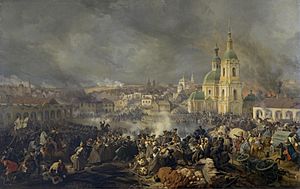 Battle of Vyazma, by Peter von Hess |
|||||||
|
|||||||
| Belligerents | |||||||
|
|||||||
| Commanders and leaders | |||||||
| Strength | |||||||
| 26,500 troops | 37,000 (24,000 engaged) | ||||||
| Casualties and losses | |||||||
| 1,800 to 2,500 | 4,000 killed and wounded; 2,000 prisoners | ||||||
The Battle of Vyazma took place on November 3, 1812. It happened during Napoleon's difficult retreat from Moscow. In this battle, a Russian army led by General Miloradovich attacked the French army's rear guard. The rear guard is the part of an army that protects the main force from attacks from behind.
The Russians caused heavy damage to the French Grande Armée. Even though the French managed to avoid being completely surrounded, they had to retreat in a messy way. This was because the Russians kept attacking them and firing cannons. The battle at Vyazma was not a huge, decisive victory, but it greatly weakened several parts of Napoleon's army during their retreat.
Contents
Why the Battle Happened
Napoleon's main goal was to lead his Grande Armée to Smolensk. This city was the closest place where they could get supplies. However, the road from Moscow to Smolensk was about 435 kilometers (270 miles) long. It was also very dangerous.
Many local fighters and Cossack raiding groups attacked the French. French supply wagons were often destroyed. About 15,000 French soldiers were captured on this road in just two months.
The French left Moscow on October 18. They tried to take a southern route to Smolensk. But after the Battle of Maloyaroslavets on October 24, they couldn't use that path. So, they had to go back and retreat along the same road they had used to march to Moscow.
This road had been badly damaged by the earlier fighting. This meant the French army faced extreme hardship. They had very little food, which led to low spirits, disorder, and even starvation among the soldiers.
The Armies on the Move
By November 3, the day of the Vyazma battle, the French army was spread out. Their column was about 97 kilometers (60 miles) long. The front of the army, led by Junot, was near Dorogobuzh. The very back of the army, the rear guard, was Davout's I Corps. They were just east of Vyazma.
Between these two points were the Imperial Guard, Joachim Murat's troops, Michel Ney's III Corps, Poniatowski's V Corps, and Eugène's IV Corps.
The French retreat was constantly bothered by Cossack attacks. Davout's corps, in particular, faced many Russian attacks. By November 2, Napoleon was not happy with how Davout was handling the rear guard. He ordered Ney to stay in Vyazma. This would allow the I, IV, and V Corps to pass him. Then, Ney would take over the rear guard duties.
Meanwhile, the Russians split into three groups to chase the French.
- First, about 5,000 Cossacks, led by Ataman Platov, followed Davout closely. General Ivan Paskevich's 26th Division, with 4,000 troops, supported them.
- Second, General Miloradovich marched a bit to the south. He had about 14,000 infantry troops and 3,500 cavalry soldiers. Miloradovich was in charge of all these troops, including Platov's and Paskevich's.
- Third, the main Russian army, led by Mikhail Kutuzov, had about 70,000 troops. They marched even further south.
On the evening of November 2, Miloradovich and his cavalry commanders were scouting south of the main road. They noticed a gap between Davout's I Corps and the IV and V Corps. Davout's troops were to the east, and the other corps were just outside Vyazma to the west. Miloradovich saw a chance to trap and destroy Davout's corps. He decided to attack early the next morning.
The Battle Begins
Russian Cavalry Attacks
At 8 AM on November 3, Miloradovich's cavalry attacked the French column. This column was spread out on the road between the I Corps and the IV and V Corps. Miloradovich also ordered his cannons, placed on nearby hills, to start firing. The weather was warm and sunny, and the attack was very successful.
The Russians captured the French IV Corps' baggage train. This caused the French soldiers to flee in confusion. Miloradovich then placed his infantry and horse cannons across the road. This cut off Davout's connection with the rest of the French army.
At the same time, Platov's Cossacks attacked Davout from the east. Paskevich's troops supported them. Davout's soldiers formed squares to defend against Platov and Paskevich. His artillery fired back at Miloradovich. Davout's 14,000 tired and hungry soldiers were now in danger of being defeated by the Russians.
French Counterattack
Luckily for Davout, the Russian attack plan had a weak point. The Russian cavalry had attacked the road without the full support of their main infantry. These infantry units were still to the south and would not arrive until 10 AM. Miloradovich had launched his cavalry attack early because he feared the gap between the French units would close.
Because they didn't have enough infantry, Miloradovich's cavalry was open to a strong French counterattack.
At this point, Davout's situation improved. His soldiers to the east pushed back Platov and Paskevich with steady musket fire. More importantly, Eugène heard the cannons firing near Davout's position. He immediately ordered his troops to counterattack Miloradovich. Their goal was to take back control of the road.
Eugène's counterattack hit the back of Miloradovich's troops who were on the road facing Davout. This attack was carried out by two of Eugène's Italian divisions. A division of Polish soldiers from the V Corps also joined, along with a single regiment sent by Ney. Ney's III Corps was positioned on the hills near Vyazma. When Davout saw these troops coming to help, he also sent his soldiers to attack.
Miloradovich's cavalry and small group of infantry were now attacked from both the east and the west. They were also hit by French cannon fire. They had to retreat from the road. Thanks to Eugène's counterattack, Davout now had a way to continue his retreat on the Vyazma-Fedorovskoye road.
Russians Keep Up the Pressure
The Russians had been pushed back, but they were not finished fighting. After retreating from Eugène's attack, Miloradovich ordered his troops to line up parallel to the road. They then began a heavy cannon attack against Davout's troops as they retreated towards Vyazma. Davout's cannons could not fire back effectively, and his troops started to panic.
An observer from the French side, Louis Philippe, comte de Ségur, described this moment: "…disorder ruled in the I Corps – the one Davout commanded. The sudden move, the surprise, and especially the sad sight of many cavalrymen without horses or weapons running in fear, threw this corps into complete confusion. This sight encouraged the enemy, who thought they had won. Their cannons, which were stronger, quickly moved into place. They began firing at an angle on our lines, cutting down our men. Meanwhile, our own guns were slowly coming back to us from Vyazma."
The Russian cannons caused so much damage that many of Davout's soldiers had to leave the road. They ran across an open field, desperate to reach safety behind Eugène's position. By 10 AM, when the rest of Miloradovich's infantry arrived, Davout's damaged corps had found shelter behind Eugène.
Eugène's troops also came under pressure from the Russians and had to fall back. General Sir Robert Wilson, a British observer with the Russians, described the fighting: "When the rest of the Russian infantry arrived (Eugen of Württemberg and Ostermann-Tolstoy), Miloradovich attacked again. He was protected by many well-served cannons. The enemy fell back to a second position. Then, when attacked on both sides, they moved to some hills in front of Vyazma. There, they were joined by two Italian divisions, the Italian guards, and Ney's corps."
According to Segur, the Russian cannon and musket fire at this point were "frighteningly effective."
At 2:00 PM, Davout, Eugène, and Poniatowski/Zajączek met. They decided that they could not win the battle. This was because the Russian attacks had caused too much confusion in the French units. Soon, the three French corps retreated into Vyazma.
Before the French corps fell back to Ney's protected position on the hills, Miloradovich asked for more troops from Kutusov. He saw that the French were weak and that a big victory might be possible. Kutusov, whose main army was only about 32 kilometers (20 miles) away, sent only 3,000 cuirassiers (heavy cavalry) led by General Uvarov. He sent nothing more.
Final Russian Push into Vyazma
At 4 PM, the fighting moved into the town of Vyazma itself. The town was on fire. By now, General Choglokov's infantry and parts of Platov's Cossacks were fighting the French in fierce, close-quarters combat on the streets. The French were under great pressure. They had to fight hard to hold off the Russians while leaving the town.
By 8 PM, the fighting was over. The corps of Davout, Eugène, and Poniatowski/Zajączek had retreated west of Vyazma. They were hurt but safe. Ney's rear guard was the last to leave the town. They suffered heavy losses in a final bayonet fight with Russian grenadiers.
To cover their retreat, the French set large parts of Vyazma on fire. Many wounded soldiers from both sides died in the flames. Russian troops entering the town were able to save some people.
That evening, Ney's corps stayed on the western edge of Vyazma to block the Russians. But the Russians were still very aggressive. According to Caulaincourt, even Ney had to "continue his retreating movement before dawn so he would not risk losing his troops."
The next day, Ney sent many grim reports to Napoleon. He described the lost battle. The road was covered for miles with burning, overturned wagons and blown-up ammunition.
What Happened After the Battle
The Battle of Vyazma was a defeat for the Grande Armée's rear guard. The French lost between 6,000 and 8,000 soldiers. About 4,000 of these were taken prisoner by the Russians. These losses were very high.
The shock of the Russian attack caused many French units to become disorganized. Because they had to retreat quickly, they never got back in order. These disorganized units became easy targets for Cossack raids in the days that followed.
General Armand de Caulaincourt, who was with the French army in 1812, described the effects of Vyazma on his army: "Until then – as long as it had to face the enemy attacks alone – the First Corps had kept its honor and good name. This was true even though it was fiercely attacked and its formation broken by the cannons. This brief disorder was noticeable because it was the first time these brave soldiers broke ranks. It forced their stubborn commander to give ground. I have told these painful details because from this event, our disorganization and misfortunes began. The First Corps, which was the largest and finest when it started the campaign, a rival to the Guard, was from then on the hardest hit; and the problem spread."
Russian casualties at Vyazma were much lower. They had no more than 1,800 killed and wounded soldiers. They had about 26,500 troops involved in the battle.
Despite the losses, Napoleon's army reached Smolensk. This saved the remaining troops for the later Battle of Krasnoi.
In Popular Culture
Leo Tolstoy mentions the Battle of Vyazma in his famous book War and Peace.
See also


